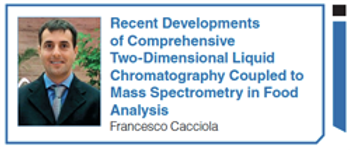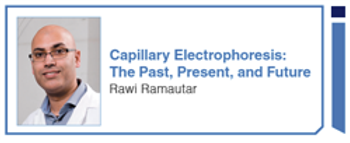
LCGC Europe
LCGC Europe is celebrating a glorious past and looking ahead to a buoyant future.

LCGC Europe
LCGC Europe is celebrating a glorious past and looking ahead to a buoyant future.

LCGC Europe
The 15th International Symposium on Hyphenated Techniques in Chromatography and Separation Technology (HTC-15) will be held at Cardiff City Hall, Cardiff, United Kingdom, from 24–26 January 2018.

LCGC Europe
In this extended special feature to celebrate the 30th anniversary edition of LCGC Europe, leading figures from the separation science community explore contemporary trends in separation science and identify possible future developments. We asked key opinion leaders in the field to discuss the current state of the art in liquid chromatography column technology, gas chromatography, sample preparation, and liquid chromatography instruments. They also describe the latest practical developments in supercritical fluid chromatography, 3D printing, capillary electrophoresis, data handling, comprehensive two‑dimensional liquid chromatography, and multidimensional gas chromatography.

LCGC Europe
In this extended special feature to celebrate the 30th anniversary edition of LCGC Europe, leading figures from the separation science community explore contemporary trends in separation science and identify possible future developments. We asked key opinion leaders in the field to discuss the current state of the art in gas chromatography instruments.

LCGC Europe
In this extended special feature to celebrate the 30th anniversary edition of LCGC Europe, leading figures from the separation science community explore contemporary trends in separation science and identify possible future developments. We asked key opinion leaders in the field to discuss the current state of the art in liquid chromatography instruments.

LCGC Europe
In this extended special feature to celebrate the 30th anniversary edition of LCGC Europe, leading figures from the separation science community explore contemporary trends in separation science and identify possible future developments. We asked key opinion leaders in the field to discuss the current state of the art in sample preparation.

LCGC Europe
Looking back, there are a great many names immortalized across all fields of science and technology, which we first hear about in the undergraduate lecture halls, and perhaps only later learn to truly appreciate as the innovators and inventors of an impactful technology that has lasted the test of time. A couple of names that at present are probably not yet commonplace in the undergraduate science class are those of Hideo Kodama and Chuck Hull.

LCGC Europe
There has been a great renewal of interest in supercritical fluid chromatography (SFC) as a performing analytical tool for various types of applications recently. SFC is particularly suitable for pharmaceutical analysis, where it is required to have separation methods offering high throughput, elevated efficiency, and, importantly, sensitivity for the determination of drugs in various matrices, such as drug formulation and biological fluids. However, SFC has also been used for other applications, including food analysis, polymer analysis, and environmental analysis, as reported in a recent review.

LCGC Europe
Food products are very complex mixtures containing organic and inorganic nutrients, and also xenobiotic substances that can derive from technological processes, agrochemical treatments, or packaging materials, including residues of pesticides, drugs, and toxins.

LCGC Europe
Inspired by the work of Jorgenson and Lukacs, 30 years ago, the group of Richard Smith at Pacific Northwest National Laboratory in Washington (USA) reported the first online coupling of the microscale separation technique capillary electrophoresis (CE) to electrospray ionization (ESI) mass spectrometry (MS) using a sheath-liquid interface.

LCGC Europe
The concept of (heart-cutting) multidimensional gas chromatography (MDGC) was introduced shortly after the invention of gas chromatography (GC). In that first experiment, the term “two-stage” was used to define the multidimensional process in applications involving the heart‑cutting of four hydrocarbon fractions, ranging from C5 to C8. The latter were separated first on a nonpolar packed column, and then on a polar one. A rather complex combination of valves enabled two-dimensional (2D) analysis. The great potential of the approach became immediately evident.

LCGC Europe
We have entered a new stage in the era of accelerations. Moore’s law continues its expansion, increasing exponentially the computer power available. Other accelerations are remarkable, particularly easy access to cloud computing and the expansion and influence of artificial intelligence to practically all sectors of our society.

LCGC Europe
Fast gas chromatography (GC) has received new attention recently in the form of available enhanced instrument capabilities. What can fast GC do for separations, and how can laboratories take advantage of enhanced separation speeds?

LCGC Europe
Perhaps the largest source of error with sampling and sample preparation, especially with solid and semisolid samples, is the sample heterogeneity. Generally, sample heterogeneity is managed by sample homogenization, such as grinding and mixing, as well as use of an appropriately large sample size. Incremental sampling methodology (ISM) involves structured composite sampling and a processing method to create an unbiased estimate of the mean concentration of soil contaminants. Hence, ISM is emerging as a preferred methodology for conducting field environmental sampling. In this month’s instalment of “Sample Preparation Perspectives”, we describe the application of ISM to laboratory subsampling protocols.

LCGC Europe
Leading chromatography vendors offer their view of the most important developments in separation science in the past 30 years.

LCGC Europe
So, what’s not in your standard operating procedure? Documenting details can prevent headaches associated with method transfers between laboratories.

LCGC Europe
The last decade has witnessed how liquid chromatography columns and instruments changed from long bulky columns with relatively large fully porous particles operated at modest pressures (100–200 bar), to short compact columns with small superficially porous particles operated at ultrahigh pressures (1200–1500 bar). This (r)evolution has resulted in a tremendous increase in achievable separation performance or decrease in analysis time, but requires a good knowledge of optimal chromatographic conditions for each separation problem and, concomitant, the right instrument configuration.

LCGC Europe
Click the title above to open the LCGC Europe November 2017 regular issue, Vol 30, No 11, in an interactive PDF format.